 The Shutdown Hits Home
The Shutdown Hits Home
An email on October 2 from Lisa Hostetler, McEvoy Family Curator for Photography at the Smithsonian American Art Museum in Washington, DC, informed me that the government shutdown engineered by the Republic Party at the command of their masters, the Tea Party, had forced the cancellation of a December panel in which they’d invited me to participate.
Organized in conjunction with the Museum’s current exhibition, A Democracy of Images, guest-curated by Merry Foresta “to celebrate 30 years of the Museum’s photography program,” the show can be accessed online at the above link. But the museum itself has closed until further notice, “due to budget restrictions and uncertainties.” So the insular, benighted beliefs of small-town midwestern white middle-aged Christians reach out to strangle cultural life in a major metropolis, our nation’s capital.
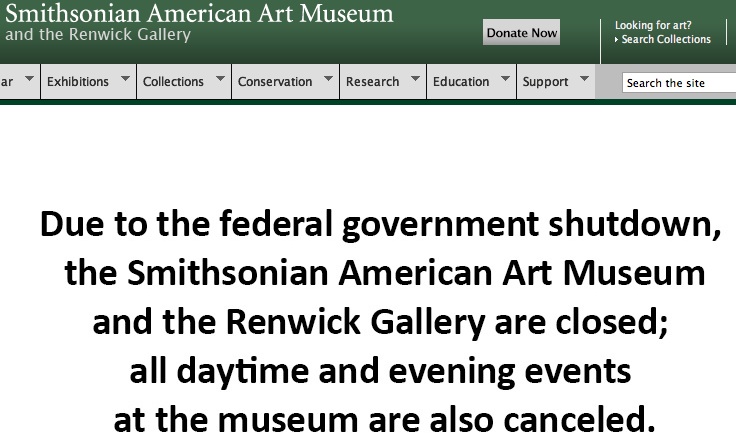
Smithsonian American Art Museum website, screenshot, 10-5-13.
Though the other panelists hadn’t been confirmed (or at least not indicated as definite to me) when the Smithsonian crew made their difficult decision, this panel promised to augment the exhibition ― whose online version I commend to you ― with some serious contextualizing material. The calibre of the invitees pretty much guaranteed a substantive dialogue within a structure Hostetler defined as “conversational,” and the museum’s intention to put an edited video of the proceedings online would have made it permanently and freely available to all.

Sen. Ted Cruz (R-TX), official portrait.
Surely this comes way low on the scale of the massive damage done by what Sen. John McCain has dubbed the wacko-bird faction, whose dementia both senile and praecox makes McCain look sane and moderate by comparison. But all news is local; this falls into my bailiwick, and affects me directly and immediately.
The Republic Party goon squad, with the malevolent John Boehner and the smirking Ted Cruz as their pit bulls, lost me the opportunity to engage with a cluster of my colleagues in putting photography from 1980 through the present in perspective, and cost me a paying gig. That makes it personal.
Death to Photography

Inner courtyard, Darul Uloom Deoband, Uttar Pradesh, India. Pixellation of faces in the original file.
Forewarned is forearmed: The Indian Darul Uloom Deoband seminary, founded in 1866 and locus of a fundamentalist Muslim sect, has issued a fatwa, or official edict, against photography itself. Click here for Shaikh Azizur Rahman’s September 15, 2013 report, “Will anyone heed an Indian fatwa against photography?” in the Christian Science Monitor. A previous fatwa from the same clerics had required Muslims to burn all personal photographs of themselves, including those “in the possession of others,” even if that required purchasing them. This new one goes a long step further.
And click here for the seminary’s online “Photo Gallery,” which promotes the institution with architectural photographs. (Seems a tad hypocritical to prohibit photographs while hyping your institution with same ― but I’m sure the ulema can reconcile this discrepancy.)
Meanwhile, two Moroccan teens have found themselves under arrest after posting on Facebook a photo of themselves kissing outside their high school, and a newspaper reprinted the photo. The charge? “Violating public decency.” They’ll appear before a juvenile court judge next week. Sympathetic peers have initiated a campaign to post a million copycat images on FB, and a sit-in is in progress outside the detention centre where they’re being held.

Egyptian teens kissing, Facebook, September 2013. Photographer unknown.
This case has evoked comparison with a similar scandal in Egypt that erupted in September when, once again, two teens posted pictures of themselves in full frontal osculation. Teenagers kissing? In public? Unashamedly? Horrors! It’s the end of civilization as some benighted Muslim mullahs know it. (And they have their Christian counterparts, I remind you.)
“To be scandalized by the normal is always demagogic,” wrote Susan Sontag.
Good luck to all these reactionaries, Muslim and Christian alike, struggling so fiercely to reverse the past six centuries of human progress. Pathetic and scary how the cumulative knowledge, experience, received wisdom, mores, superstitions, and prejudices of goatherds and subsistence farmers living a millennium or more ago can determine the thinking of so many alive today, all around the globe.
“Fugitivart” Panel Video Online
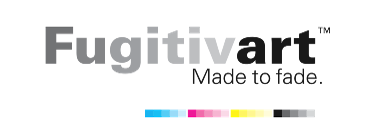 On a more positive note, the video of a panel on the subject of “Fugitivart: Made to Fade,” held at the School of Visual Arts on September 12, 2013, is now online at iTunes U. Held in conjunction with an exhibition at the SoHo Photo Gallery curated by Susan Keiser and Scott Lerman, the panel’s members included myself; Michael Foley, SVA faculty member and owner of Foley Gallery; Jon Cone of Cone Editions Press, master printer and pioneer in ink jet printing; and the inimitable W. M. “Bill” Hunt, collector and gallerist.
On a more positive note, the video of a panel on the subject of “Fugitivart: Made to Fade,” held at the School of Visual Arts on September 12, 2013, is now online at iTunes U. Held in conjunction with an exhibition at the SoHo Photo Gallery curated by Susan Keiser and Scott Lerman, the panel’s members included myself; Michael Foley, SVA faculty member and owner of Foley Gallery; Jon Cone of Cone Editions Press, master printer and pioneer in ink jet printing; and the inimitable W. M. “Bill” Hunt, collector and gallerist.
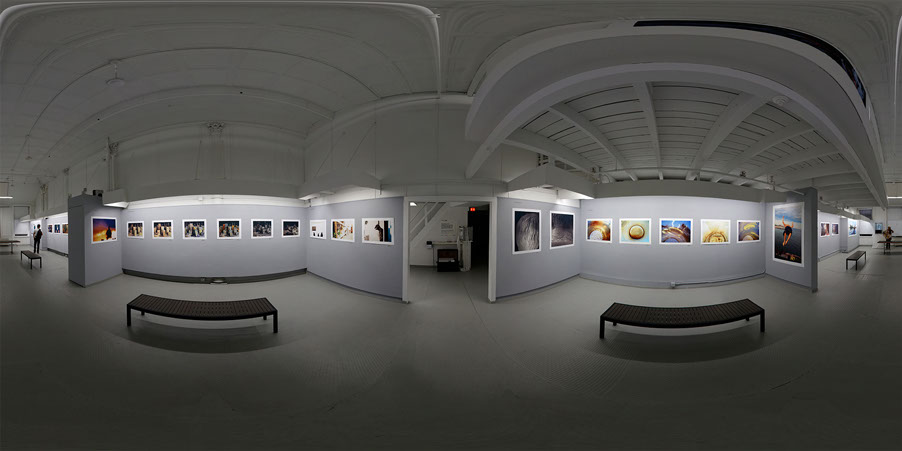
Fugitivart installation, SoHo Photo Gallery, September 2013. Photo © copyright 2013 by Scott Lerman.
This panel took as its premise the Fugitivart exhibition, which consisted of digital prints of images by 23 picture-makers, prints specifically engineered to fade and eventually disintegrate. (There’s a Blurb catalogue available.) Keiser and Lerman intended this to explore the option of ephemerality in photography as printmaking, as an alternative to the presumed desideratum of archival permanence. An odd, provocative idea, which I think evoked some intriguing ruminations from our foursome.
Decide for yourself. As always, you’re welcome to post comments below.
Better Late
![]() An online search unexpectedly brought up a July 6, 2002 review of my 1998 book Depth of Field by one Nabil “Nadreck” Maynard, currently of Portland, OR, heretofore unknown to me. It appeared at his blog, nadreck.me: Maunderings of a Digital Self. (I do admire a man capable of correct usage of the word “maunderings.”)
An online search unexpectedly brought up a July 6, 2002 review of my 1998 book Depth of Field by one Nabil “Nadreck” Maynard, currently of Portland, OR, heretofore unknown to me. It appeared at his blog, nadreck.me: Maunderings of a Digital Self. (I do admire a man capable of correct usage of the word “maunderings.”)
Maynard’s current self-description: “Most recently, his work has centered around software test engineering, while pursuing long term interests in social computing, cyborg anthropology, and digital media.” In short, not someone grounded in photography, though he indicates that he’s read a previous book of mine, Critical Focus (1995).
Which simply contextualizes his extended, thoughtful response to the book as a whole and its individual essays. Extremely useful for me, as the author, to watch an attentive lay reader make his way through this work of mine. Don’t know how I missed this until now. Belated thanks to Maynard for taking the time to write and post this commentary.
Portraits of My Pupils
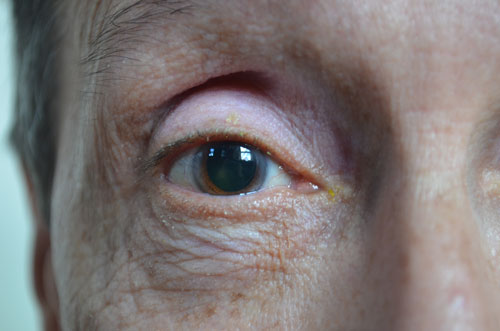
A. D. Coleman’s right eye with dilated iris, 9/25/13. Photo © copyright 2013 by Anna Lung.
Medicare requires me to take an annual glaucoma-screening test. I had one last December, by an opthalmologist not in my designated provider’s system. To dilate my irises (in order to photograph the back of my eyeball), his machine blew a short puff of air into my eye.
This year, to save a bit of money, I went to a different opthalmologist on September 25, one within my provider’s network, for a no-cost exam. An older doctor, with less cutting-edge equipment, he put drops in my eyes to achieve the necessary dilation of the irises. The results came out fine, as they had a year ago; I’m glaucoma-free. (In fact, my vision has improved in recent years; I now wear glasses only when driving or outdoors and needing to see long distances.)
But he neglected to inform me that as a side effect of those drops my irises would remain dilated for hours; that bright light ― like the hot sun shining outside at that very moment ― would dazzle me; that I’d need sunglasses outdoors; that I shouldn’t drive; and that, if I’d come by car, I should have brought a designated driver with me.
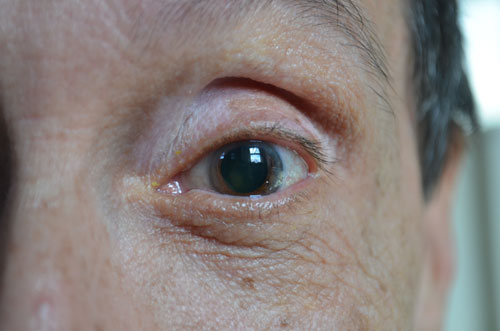
A. D. Coleman’s left eye with dilated iris, 9/25/13. Photo © copyright 2013 by Anna Lung.
I’d gotten there via public transportation, fortunately, so incapacity for driving didn’t create any problems. But, as soon as I stepped out the door of his office into the noonday sun, the intensity of the light almost knocked me to the pavement. An overwhelming visual experience, everything glowing and almost painfully saturated, comparable in my experience only to my few LSD adventures in the Sixties.
Fortunately, I had sunglasses with me, and the disorientation didn’t keep me from getting home safely. But still. The idiot might have given me some advance warning. I stayed indoors for the rest of the day. Six hours later my irises were still dilated to the extent you can see in these photos, made by Anna.
Weather (Or Not)
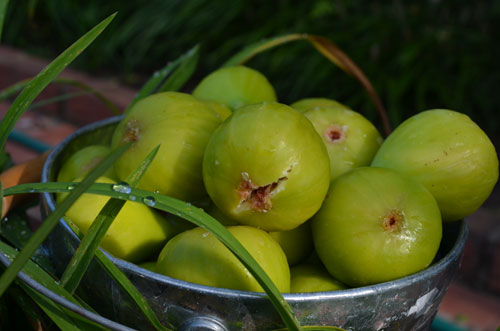
Bucket of figs. Photo © copyright 2013 by Anna Lung.
Indian summer here in the New York area, shirtsleeve weather, warm sunny days interspersed with San Francisco-style fogs and cool but not yet chilly nights, sheer delight. Feels like an actual classic autumn in New York, of which we’ve had a scarcity these past two decades, as rare now as classic Big Apple springtimes. We’re relishing it, along with the prolonged bounty from our little garden that it facilitates:
- our first harvest of white Kadota figs, from a tree given to us by a neighbor, planted two years ago ― 200 figs this year (and counting);
- several varieties of heirloom tomatoes, all of which taste like actual tomatoes, 50 pounds so far from 5 plants, the beefsteaks close to 2 pounds when ripe, cracked on top and catfaced on the bottom ― so delicious that I weep as I eat them, thinking of the flavorless imitations we get at the local supermarket;
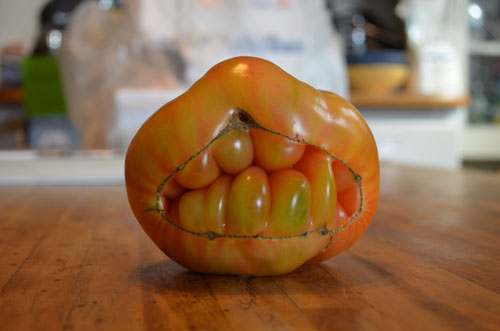
Catfaced tomato (Cheshire variety). Photo © copyright 2013 by Anna Lung.
- a dozen volunteer acorn squash (seeds from our mulch heap, we figure) that I broil cut in half and stuffed with minced apples and raisins sprinkled with curry powder;
- pink raspberries that provide a handful or two of deliciousness daily;
- decorative purple basil, regular basil, and Thai basil, for cooking and pesto;
- habañero peppers so hot that merely waving one at any dish raises it to 5-alarm status, dozens from a single plant;
- catnip with which we get our cats stoned (also enjoyed by neighborhood felines).
Hope you have similar bounty and good weather chez vous. Enjoy it while it lasts. They say we’ll have a long, hard winter.
•
This post supported by a donation from Norbert Kleber.






Ha! (with empathy) at your eye exam, Mr. Coleman. Having experienced the same recently, I at least remembered to take my temporary roll-up sunglasses that fit behind my regular specs. Even with the typical Pacific Northwest overcast, though, it was a bit of a shock walking outside to the car. There’s got to be a better way to shorten the wide-eyed time!
On a serious note, with the brevity of the shutdown, has your presentation at the American Art Museum been rescheduled at all, or is it just off the books for now?
Congratulations on your garden harvest!Nothing better than a fresh, home-grown tomato…or two.
Cheers, Allan!
Richard
I stand corrected. Further research indicates that the eyedrop technique yields more accurate and reliable results than the puff-of-air method. There’s a newer technology, from Finland, better than either of the earlier techniques but not yet in widespread use here.
Apparently, having been forced to cancel, the Smithsonian couldn’t reschedule the planned panel, as some of the funding for it got lost in the shutdown.
Perhaps I’ll do something with them in the future.
On the up side, they reopened as soon as they could, so the exhibition “A Democracy of Images: Photographs from the Smithsonian American Art Museum” is once again on view and will remain up through January 5, 2014.
We’ve had our last tomato from the garden, which we’ve now bundled up against the coming winter. Still many batches of tomato sauce in the freezer to tide us over till spring.